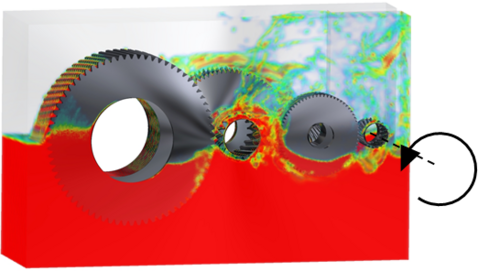Research Topic
| Short Title | Simulation Gearbox Oil Flow |
| End of Project | 2022 |
| Funding | FVA-Nr. 857/I, IGF-Nr. 20241 N/1 Federal Ministry for Economic Affairs and Climate Action, BMWK |
| Contact | Division EHD-Tribocontact and Efficiency |
Project Description
When developing drive systems, high efficiency and sufficient load-carrying capacity are key development goals. An optimized lubrication system in a gearbox ensures sufficient lubrication and cooling of machine elements such as gears and bearings. Computational Fluid Dynamics (CFD) can be used to obtain relevant information on the lubricant balance at an early stage of the development process, thus strengthening targeted gearbox development.
The objective of the research project FVA 857 I "Transmission Oil Flow Simulation" was the development and validation of a simulation methodology for CFD simulation of oil flow and no-load gear power loss in dip-lubricated transmissions and the derivation of a best practice guideline for gearbox oil flow simulation. With the developed simulation methodology, the influence of oil-specific and geometric parameters on oil distribution could be investigated, as exemplified in Figure 1. The simulation results were also used to develop a basic understanding of the interaction of gears with oil and air, where pressure and shear forces were found to be particularly relevant. The oil distribution was found to have a significant influence on the no-load gear power loss. It was also found that the circumferential speed, the direction of rotation and the lubricant viscosity in particular influence the loss torque. Figure 2 shows an example of the simulated oil distribution of a practical gearbox.
In the further project FVA 857 II, the potential of the Smoothed Particle Hydrodynamics (SPH) method for oil flow simulation of practical gearboxes is examined. In future projects, thermal CFD simulations can be used to investigate the heat balance of gears.

